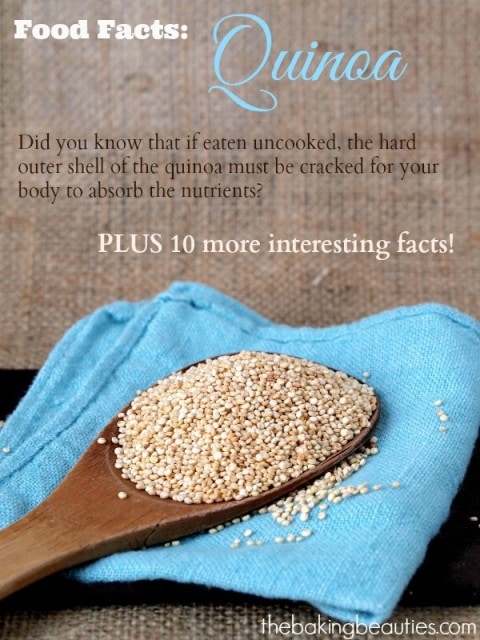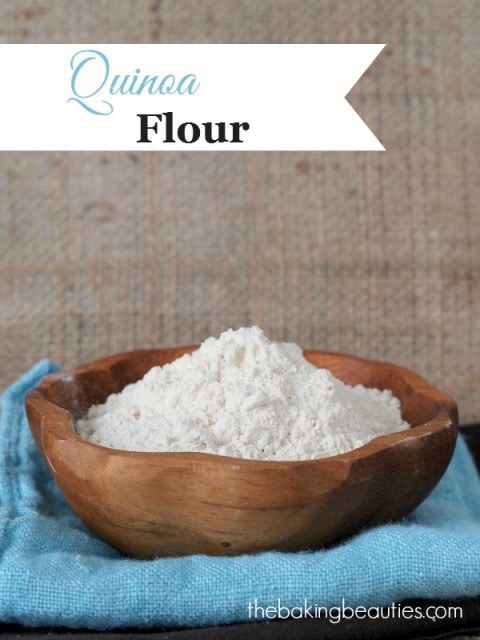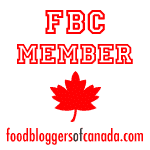We’re going to be starting a new feature on The Baking Beauties today – Food Facts. With food facts, we will cover an ingredient used in gluten free cooking or baking, and share with you what it is, where it’s from, its history, and how to use it. This will be usually be followed by a few recipes that use the featured ingredient. If there are any ingredients that leave you scratching your head, please leave a comment and we’ll feature that ingredient in future articles.
Today, we will be sharing Food Facts about Quinoa. Quinoa (pronounced keen-wah), with its versatility and high nutritional value, has become very popular the last few years.

1. Quinoa is Andean in origin. It was first cultivated in the high altitude planes of Bolivia, Chile and Peru. It was domesticated in the “Altiplano” region surrounding Lake Titicaca around 3000 to 4000 years ago. The ancient Inca subsisted on quinoa calling it the “Mother Grain.” In more recent times, quinoa has been a staple for the Quechua and Aymara people, the descendants of the Inca.
2. Quinoa is not a grain. It is considered a pseudo-cereal because it comes from a broadleaf plant not a grass. Like most domesticated plants, quinoa has undergone many changes due to human activity. These changes include selecting for larger seeds, thicker stems, loss of seed dispersal and more compact flower/seed clusters. The seeds consist of an outer shell called a pericarp that protects the embryo and an inner perisperm. The embryo is high in protein and lipids.
3. Quinoa seeds, when used raw, need to be cracked before they are used. The hard outer shell, or pericarp, contains saponins, which are toxic and bitter tasting and act as a defense for the plant against animal ingestion. Removing the saponins and cracking the pericarp increase the digestibility of quinoa. Washing removes the saponins and most commercially available quinoa has been through enough washing processes to completely eliminate the saponins.
4. Quinoa is a species of goosefoot. Scientifically it is classified as a Chenopod and it is closely related to other species including sugar beets, Swiss chard, spinach, tumbleweed and Lamb’s quarters.

5. Quinoa is available in many varieties and variations. The Andean region, where quinoa was first domesticated, contains dozens of varieties of quinoa but there are three main varieties used in North America identified by the Whole Grains Council: White, red and black quinoa. White quinoa is the most abundant and least flavourful variety. Red and black quinoa are both a bit earthier, and red Quinoa holds its shape better than white, making it great for use in salads. Black Quinoa retains its shape and bold colour when cooked.
6. Quinoa is considered a super food because of its nutritional value. It is high in protein and amino acids. The seeds are especially high in the amino acid Lysine which is unusual in the plant kingdom. The nutritional value of quinoa is very similar to the profile that results when soybeans and wheat are combined. Quinoa provides a suitable amino acid pattern to meet human nutritional needs and comes as close to providing all the nutrients necessary for sustaining life. Thus it is a good choice for vegetarians.
7. Quinoa can be used in its seed form. It can also be ground into flour, processed into flakes, or grown into sprouts. This little seed with a funny name is a very versatile ingredient that can be used in all kinds of cooking, baking, and food preparation. Quinoa flour is high in protein and has a slight nutty flavour, but using too much in a recipe can leave an unpleasant taste to your baked goods. Quinoa flakes can be used similar to oatmeal, but they have a finer texture.
8. Quinoa has been studied for years but only introduced into the mainstream North American market recently. The first 50 pound bag was imported in the early 1980’s by the Quinoa Corporation. Since then quinoa has become a world traveler. It is successfully cultivated in over 70 countries including European nations. France, England, Sweden, Denmark, Holland, and Italy all grow quinoa, however, over 90% of production still occurs in the Andean region where it was first cultivated – primarily Peru and Bolivia.

9. Quinoa has been successfully farmed in Colorado and Nevada. In fact, according to the United Nations Food and Agricultural Organization, the United States is the third largest producer of quinoa. Ecuador, Argentina, and Canada all follow the U.S. in annual production quantities.
10. Quinoa is ideal food for astronauts. In 1993 NASA released a study they had carried out to see how quinoa would perform in a “Controlled Ecological Life Support System (CELSS)” program. NASA researchers were able to get the plant, which usually takes 4 to 5 months to mature, to mature in only 3 months. The study showed that quinoa, due to its nutritional value and excellent response to growth in a controlled environment, made it an “ideal candidate crop for CELSS.”
11. Quinoa is an important global food product. Its nutritional content and potential as a subsistence and export crop for the Andean farmers who continue to cultivate it, has propelled it to the forefront of the global fight against hunger and food insecurity. The United Nations recognized this and declared 2013 the “International Year of Quinoa.” The Food and Agriculture Organization of the UN held several events during 2013 in support of the International Year of Quinoa, including the production of several free, downloadable cookbooks: http://www.fao.org/quinoa-2013/publications/recipe-books/en/
CLICK HERE for more delicious gluten free recipes featuring quinoa.
Keep your eyes open for two new quinoa recipes I will share later this week!


Robyn says
Very informative, thank you!
Jeanine Friesen says
You’re welcome, Robyn!
Lorna says
AS I went through this post I arrived at a recipe for French Bread. One of the ingredients used in your flour mix was gelatin….and I’ve seen this a few times. What role does the gelatin play and why do we only see it in recipes very occassionally?
Jeanine Friesen says
Yes, Gelatin! That recipe is from Bette Hagman, who used a lot of gelatin and pectin in her bread baking. The intent, I believe, was to up the protein in the bread, and to help give it texture. Every recipe developer seems to have their own way of doing things – I use a lot of milk powder or almond flour in my bread baking, while others might use psyllium husk or ground chia seeds. So, none of the recipes I’ve developed myself have it, but there are some that do.
Terri Davila says
Great info & looking forward to the next segment. We use quinoa often especially the flakes for cookies since my son can not eat oatmeal. I have used this in bread baking but would like to learn results if more than 1/2 cup was used. I gotta play with this.
Jeanine Friesen says
Thanks, Terri! I think too much might end up in a heavier loaf of bread, but that’s just a guess.
Susan Taylor says
Jeanine Thank you so much for this information and recipes.
Gwen says
I would like tips on how to wash quinoa – I haven`t found a strainer with fine enough mesh and lose so much down the sink when washing it to get rid of the bitter outside. TIA
PeggyLynn says
Interesting. Can I mill my own?
Jeanine Friesen says
You can mill your own, PeggyLynn – here’s some info on that: http://powerhungry.com/2012/05/quinoa-flour-101-make-your-own-quinoa-flour/
FKP says
Thank you for all the info on quinoa. I use it in soups in place of barley, it takes on the flavor of the soup, very good. The best way to rinse it I have found is a gold coffee filter. You can get the in most stores, works really good.
Gwen says
Thanks for the coffee filter idea will try it!
Jeanine Friesen says
Great tip on rinsing it, FKP! Thanks for sharing!